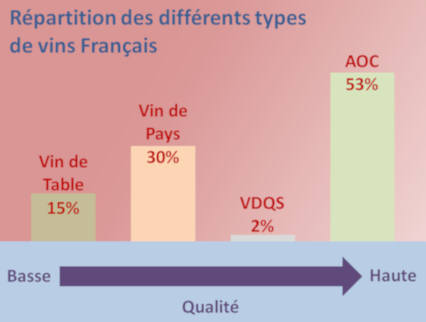4 categories of wine are mainly produced in France:
Until 2009, in accordance with European regulations, French wines were classified into four families (see below). But since the 2009 harvest , there has been a change in the classification governed by the European Commission, the Commission decided as follows :
- Vins de Table become wine AOP VSIG (vin sans indication géographique), with name Vin de France with or without grape variety and vintage.
- Vins de Pays become wine IGP (indication géographique protégée).
- AOC become wine AOP (appellation d’origine protégée).

Vin de France (15%) (Old name : Vin de Table):
Vin de table means Table wine, it is a wine term for wines without wine classification. Vin de Table is the most basic variety of wine. There are two kind of vin de table : Wines using a mix of european grapes are called european table wine and wines using only grapes from France are called Vin de table français.
IGP (Indication Géographique protégée) (30%) (Old name : Vin de Pays):
Vin de pays is a French term meaning "country wine". Vins de pays are a step in the French wine classification which is above the table wine (Vin de table) classification, but below the VDQS and Appellation d'origine contrôlée (AOC) classifications. Legislation on the Vin de pays terminology was created in 1973 and passed in 1979, allowing producers to distinguish wines that were made using grape varieties or procedures other than those required by the AOC rules, without having to use the simple and commercially non-viable table wine classification.
Unlike table wines, which are only indicated as being from France, Vin de pays carries a geographic designation of origin, the producers have to submit the wine for analysis and tasting, and the wines have to be made from certain varieties or blends.
Regulations regarding varieties and labelling practices are typically more lenient than the regulations for AOC wines.
VDQS (2%) :
Vin Délimité de Qualité Supérieure ("Delimited Wine of Superior Quality"), usually abbreviated as VDQS, is the second highest category of French wine, below Appellation d'Origine Contrôlée (AOC) in rank, but above Vin de pays (country wine).
VDQS is sometimes written as AOVDQS, with AO standing for Appellation d'Origine.
VDQS wines are subject to restrictions on yield and vine variety, among others.There are relatively few VDQS, as they typically move onto AOC status after a number of years, so VDQS represents a small part of the total French wine production.
AOP (Appellation d'origine Protégée) (53%) (Old name :: AOC (Appellation d'Origine Contrôlée)
p>Appellation d’origine contrôlée (AOC), which translates as "controlled term of origin" is the French certification granted to certain French geographical indications for wines, under the auspices of the government bureau Institut National des Appellations d'Origine (INAO). It is based on the former concept of terroir.The INAO guarantees that all AOC products will hold to a rigorous set of clearly defined standards:
- AOC wines products will be produced in a consistent and traditional manner with ingredients from specifically classified producers.
- Wine will be produced in designated geographical areas.
- The products must further be aged at least partially in the respective designated area.
